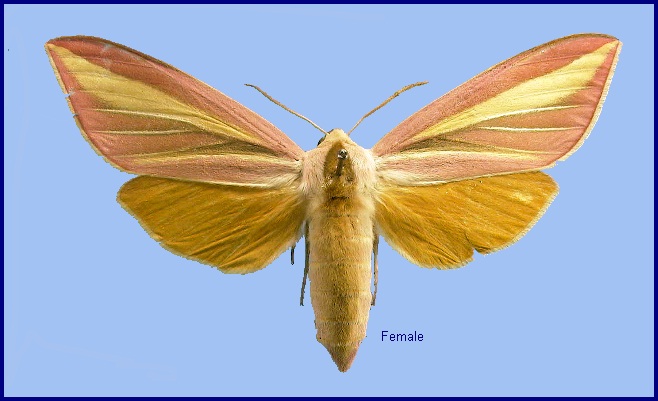
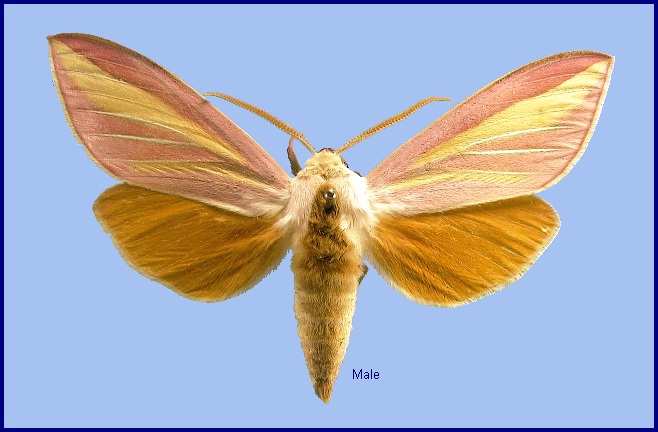
Leucophlebia lineata Westwood, 1847, Cabinet oriental Ent.: [46], pl. 22, upper figure. Type locality: "Central India, Assam, etc."
Synonym. Leucophlebia vietnamensis Eitschberger, 2003.
Note. The designation of the female syntype in the OUMO as lectotype by Eitschberger, Neue ent. Nachr. 56: 9 (2003), is invalid under Article 74.7.3 of the ICZN because an express statement of the taxonomic purpose of the designation was not given.
Wingspan: 62--82mm. Palpus and frons brown; antenna ochreous; vertex of head and sides of thorax and abdomen pale pink: a brownish-ochreous stripe on vertex of thorax and abdomen. Forewing upperside similar to other Leucophlebia in having broad pinkish costal and outer marginal areas and a paler median band, but differs in having the hind margin paler, nearer the colour of the median band, and with veins M3, Cu1 and (to a lesser extent) Cu2 picked out in white. Hindwing tawny. Cilia yellowish-white.
In the male genitalia, uncus narrowing gradually to truncated apex, impressed longitudinally, with slightly elevated and strongly sclerotised lateral edges. Gnathos with a broad, rounded mesal lobe. Valva sole-shaped, apex evenly rounded; basi-dorsal tuberculated process short. Harpe without distinct processes and ridges. In the female genitalia, tergum A8 with truncated with angles rounded. Sterigma not strongly sclerotised, posterior part truncate with sides oblique. Ostium bursae with edges somewhat raised, processes absent.
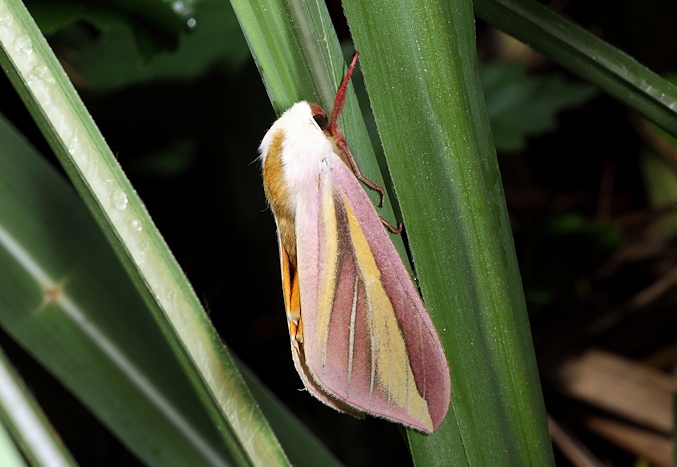
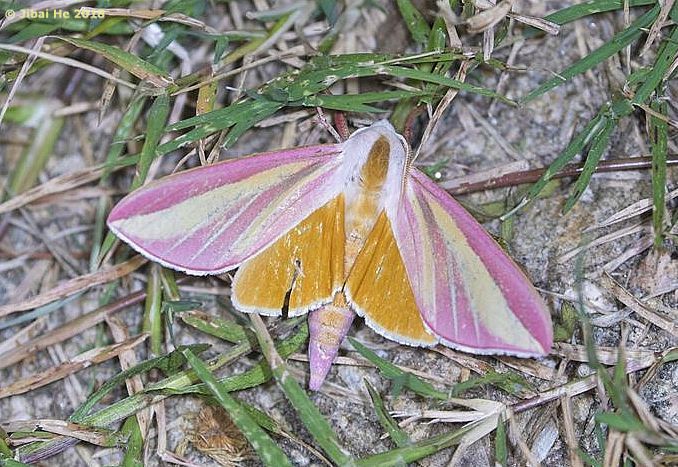
The moth sits with the wings held steeply penthouse-wise, unlike others of the subfamily which, except for Leucophlebia emittens), hold them horizontal. It came to light freely in India, but was never caught feeding on flowers, as the tongue is weak and functionless (Bell & Scott, 1937).
China: iv-v (Hong Kong); vi (Hubei; Guangxi); 20.vii (Shandong); vii (Jiangxi); viii (Hong Kong; Shandong; Fujian); 12.ix (Hong Kong).
Taiwan: 25.iv-4.v (Tainan Hsien); 12.v (Nantou Hsien); 9.vi (Kaohsiung Hsien); 12.vi (Kinmen Hsien).
OVUM: Pale yellow or yellowish-white, oval (1.00 x 1.60mm), shiny and smooth. Laid singly on both sides of leaves of sugarcane and other coarse grasses (Bell & Scott, 1937).
LARVA: Full-fed 55--75mm. In the first instar, head round, without processes; horn straight and very short; colour yellowish. Second instar: head triangular, with very short, blunt processes; horn longer; colour green. By the third instar, horn about the same length, shorter in proportion to the size of the body; colour green. [Fourth instar not recorded.]
Fifth and final instar, head triangular, vertex rounded, without processes, much higher than segment 2. Surface of the head dull, covered with small tubercles. Body long and thin, nearly cylindrical, surface dull: prolegs and claspers small. Horn short, straight, thick at the base and tapering sharply to a point. The secondary rings of the body clearly defined, each ring with a transverse row of small tubercles; a dorso-lateral stripe, formed of a larger pointed tubercle on each ring, from the front margin of segment 2 to the base of the horn. Horn, anal flap and claspers set with small tubercles. In colour, head very pale green; a rose-coloured cheek-stripe, broad at the base of the antenna and narrowing upwards to a point below the vertex; the tubercles white. Body grass-green or brick-red, the tubercles white; the dorso-lateral line of larger tubercles rising from a broad white dorso-lateral stripe. Horn brick-red in both colour forms, with a white stripe from base to tip in continuation of the dorso-lateral stripe; the true legs rose-coloured in both forms; prolegs and claspers green in the green form, rose-coloured in the brick-red form. Spiracles flush, oval, pale yellow, with the central slit brown (Bell & Scott, 1937).
The larva lies along the midrib of a leaf or along the stem, and is difficult to detect. Pupation in a cell underground, but the larva frequently fails to pupate after burying itself in the earth, or remains for months in the larval state before changing into a pupa, the moth emerging soon after pupation finally takes place (Bell & Scott, 1937).
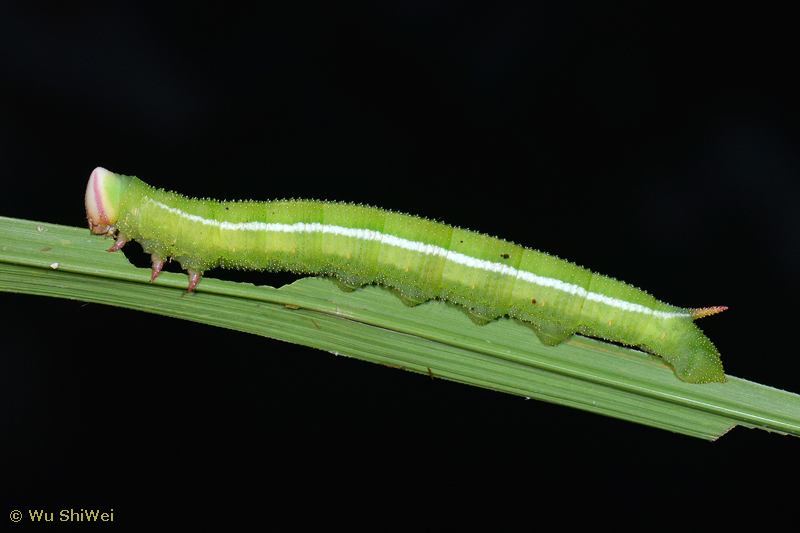
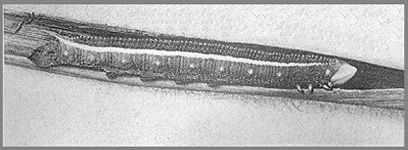
PUPA: 29--35mm. Colour brownish-ochreous, the head and abdominal segments 10 and 11 rusty-red, spiracles and cremaster black. The head rather small, dorsal line of thorax rising sharply; tongue the same length as foreleg, strongly narrowed distally; antenna shorter than foreleg; the foreleg broad, the mid-leg narrow; coxal piece just visible. Surface smooth and shining; legs and veins of wings not prominent; front margins of abdominal segments minutely pitted; ante-spiracular ridges on abdominal segments 6 and 7. Cremaster with the base broad, narrowing suddenly to a simple point.
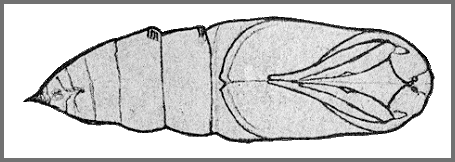
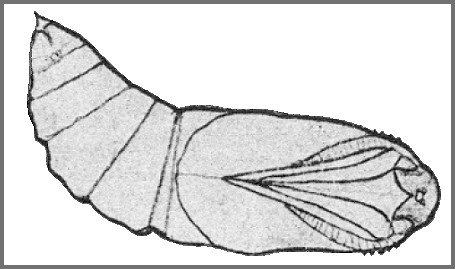
Larval hostplants. Coarse grasses (Poaceae). In Taiwan on Saccharum sinense and Saccharum spontaneum. A minor pest of sugarcane (Saccharum).
China: Hebei; Beijing; Tianjin; Shandong (Weihai; Yantai; Qingdao; Tai Shan); Shaanxi; Zhejiang (Tianmu Shan); Hubei (Mt. Guifeng, Macheng); Yunnan; Hunan (Dayong); Jiangxi (Jiujiang; Jiuling Shan); Fujian; Guangdong; Hong Kong; Guangxi; Hainan.
Taiwan: Taipei Hsien (Wulai); Kaohsiung Hsien (Liukuei, 300m; Chishan); Tainan Hsien (Kuantzuling); Nantou Hsien (Puli); Kinmen Hsien; Orchid Island/Botel Tobago.
Sri Lanka, India (Pathania, Sunita Sharma & Gill, 2014), Pakistan (Punjab) (Rafi et al., 2014), Nepal, Thailand, eastern and southern China, Taiwan, Cambobia, Vietnam (Le & Vu, 2024), Malaysia (Peninsular, Sarawak), Indonesia (Sumatra, Java, Kalimantan, Flores, Sulawesi) and the Philippines (Inoue, 1996).
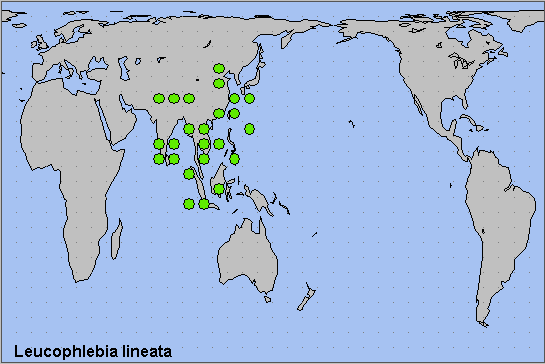
 Return to Sphingidae of the Eastern Palaearctic species list
Return to Sphingidae of the Eastern Palaearctic species list